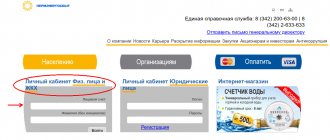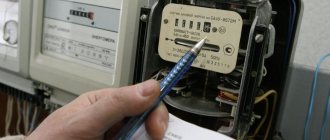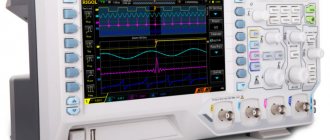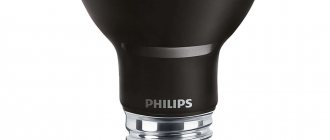The subscriber can save on electricity if he uses differentiated tariffs. According to the Decree of the Government of the Russian Federation No. 354 of May 6, 2011, it is possible to pay for electricity at a uniform rate for the region or energy prices based on the time of day and hours of load on the network (peak zone).
Flat rates are determined by default and are mandatory for the apartment owner after concluding an energy supply agreement. Differentiated time of electricity consumption is an option when the homeowner can save money on utility bills. To pay at reduced rates, you must enter into an agreement with the supplying company. The night tariff for electricity is set by local regulations and is calculated based on the indicators of a two-phase meter (T1, T2).
Two-tariff and three-tariff accounting systems
During the day, uneven consumption of energy resources is possible. During the day, especially on weekends, the load on the network may be greater: people are at home and actively use household appliances. At night there is less pressure on electricity consumption. If the equipment operates in an uneven mode, then excessive consumption of electricity, load on the networks and, as a result, failures and accidents in the operation of substations are possible.
At night, the use of energy resources is less due to the low activity of citizens. You can use electricity meters on a day-night system. The daily rate is calculated based on the presence of an electric stove in the apartment or the location of the household in a rural area. Nighttime electricity consumption is also calculated depending on the presence of electric stoves in the living space and the location of the household outside the city.
The two-tariff metering system assumes differentiated rates according to the “day-night” system, which will require the installation of a meter that records electricity automatically. Within the same locality, the nightly tariff for electricity may be different (for example, in Moscow and New Moscow). The three-tariff meter is designed for separate metering of energy consumed during the day, night, and peak (half-peak) times.
To calculate the amount you need to pay for consumed energy, the differentiated rate is multiplied by the volume of the resource used.
Monthly amounts for electricity consumed in each day zone are written down on the receipt as a separate line.
The subscriber must take into account the time from which the conditions for charging for energy at night begin to apply. Then you can start saving. To do this, it is advisable to turn on all devices that consume a significant amount of energy during phase II. Daily electricity consumption is taken into account separately.
When using a differentiated meter, the user pays for energy resources within the daytime, including peak, and night zones. Such a system is not common due to the insignificant difference between the peak and half-peak time periods. Payments by consumers, broken down by rates, are carried out taking into account the technical features of the meter (phases T1-T3). From January 1, 2017, differentiated rates are in effect for citizens in most major cities.
Formula and calculator
The electricity calculator will calculate how much residents of Moscow and the Moscow region need to pay for electricity. Rates are listed below. If you have a single-tariff system, you just need to fill out the first three fields and click on the “calculate” button. If the system is two-tariff, fill out six fields; if it is a three-tariff system, then fill in all nine.
To calculate how much to pay for electricity, you need to take readings at the beginning of the billing period and at the end. Subtract the first from the second value. This figure shows how much electricity you burned. Then you multiply the resulting number by your tariff and get the amount to pay.
S=(AB) x C, where
S — amount to be paid
A - meter reading now
B - meter readings for the previous (already paid) period
C - tariff.
If you have a two- or three-tariff system, you need to calculate the amount for each tariff separately and add it up.
Download current tariffs:
- Order of DEPiR of Moscow dated December 18, 2020 No. 359-TR;
- Order of the Committee on Prices and Tariffs of the Moscow Region dated December 16, 2020 No. 256-R.
Electricity tariff “day-night”
It provides for payment of electricity in two zones. Night time is considered from 23:00 to 7:00 am. If the meter works correctly, then it counts the electricity consumed after the specified time intervals. The subscriber must take readings every month, enter data on energy consumption during the day and night into the receipt, and make timely payments. Fees per kilowatt/hour are differentiated. Typically, the reduced rate applied at night is partially offset by the higher rate for daytime electricity consumption.
How to choose an electricity tariff in the Moscow region
More and more residents of the Moscow region are consciously approaching the choice of electricity tariff. The cost of this utility service is currently based on several conditions. If you know all the nuances of determining the final price for electricity, you can save a lot of money. Read about what electricity tariffs are in the Moscow region and which one is better to choose in the material of the mosreg.ru portal.
Gas or electric stove
The cost of supplied electricity directly depends on the type of stove and heating appliances installed in the house. If the stove is gas, then the price of one kilowatt/hour will be 5.04 rubles, and if it is electric - 3.53 rubles. Electricity tariffs also vary depending on the time of day. In this case, the cost of a single-rate tariff is given.
Such a significant difference (more than 30%) is explained by the fact that electric stoves consume a large amount of electricity, and the reduced rate allows the final price tag not to soar to enormous values. The same goes for electric batteries. However, it should be remembered that all equipment must be officially installed and included in the project documents for the house.
How to gasify a private house in the Moscow region>>
Differentiated tariffs for citizens
In the case of a single-rate tariff, the cost of one kilowatt/hour of electricity is fixed and does not change.
As for differentiated tariffs, the price for electricity fluctuates depending on the time of day. So, you can choose tariffs where the cost of electricity is divided into two or three time periods. The two time zones are daytime (from 7 a.m. to 11 p.m.) and night hours (from 11 p.m. to 7 a.m.). At the same time, the cost of night hours is much lower - 2.09 rubles per kilowatt/hour versus 5.80 rubles per kilowatt/hour during the day (the cost is indicated for houses with gas stoves). The night rate is almost 3 times lower than the day rate. This means that people whose main electricity consumption is at night have the opportunity to save a lot.
Another tariff plan involves differentiating the cost of a kilowatt/hour over three time periods. From 7 to 10 a.m. and from 5 to 9 p.m., electricity is the most expensive (6.55 rubles), since this is the peak period. Half-peak falls on the time periods from 10 to 17 hours and from 21 to 23 hours (5.04 rubles). The cost of consumption at night (from 11 p.m. to 7 a.m.) is the same as with a two-rate tariff (2.09 rubles per kilowatt/hour).
The cost of differentiated tariffs is also given for houses equipped with gas stoves.
How to apply for technical connection to electrical networks in the Moscow region>>
Tariffs for rural population
The cost of a kilowatt/hour of electricity for residents of rural areas differs from the price of a kilowatt/hour in cities. For all tariff plans it is significantly lower. Moreover, it is identical to the cost of all tariffs for residents of cities whose homes are equipped with electric stoves. The single-rate tariff is 3.53 rubles per kilowatt/hour, the two-rate tariff is 4.06 rubles during the daytime, and 1.46 rubles at night. In the three-rate tariff, the peak zone is 4.59 rubles, and the half-peak zone is 3.53 rubles per kilowatt/hour.
Thus, for an ordinary resident of the Moscow region, the optimal choice would be one-rate and two-rate tariff plans. The latter is suitable for those citizens who consider themselves night owls and for some reason stay awake at night. As for the three-rate differentiation, such a choice is advisable only under the condition of clear control of electricity consumption by the resident.
How to pay for housing and communal services online in the Moscow region>>
For other consumer groups
Some consumer groups are considered equal to the population, and the same tariffs apply to them. These are, for example, residential areas at military units and correctional labor institutions, homeowners' associations and various cooperatives, gardening or gardening associations of citizens. In addition, the same tariffs are used to calculate the cost of a kilowatt/hour for religious organizations that are supported by parishioners. So, with a one-rate tariff it costs 5.04 rubles, with a two-rate tariff it costs 5.80 and 2.09 rubles, and with a three-rate tariff, depending on the reduction in peak consumption, it costs 6.55, 5.04 and 2.09 rubles.
For non-public groups, tariff rates may vary depending on the required network voltage, power and time of day. The price of a kilowatt/hour is determined in this case during market trading.
Find out how to recalculate housing and communal services when leaving home>>
Ivan Pyshechkin
What time does the night electricity tariff start from?
To find out the hour from which the night zone is calculated, you need to take into account the content of local regulations. When calculating electricity charges, it starts at 11 pm and ends at 7 am. During this period, amounts for electricity are charged in a smaller amount, taking into account the presence of an electric stove and other energy-intensive household appliances at home. The timing of the nightly electricity tariff is usually unchanged in most localities.
Peak Electricity Zone: Time
In most local acts, the tariff, differentiated by three zones of the day, is calculated as payment by the hour. It provides:
- daily rate - calculated until 23:00 (divided into zones: peak zone - from 7 to 10 am, from 5 to 9 pm);
- half-peak period - from 10 am to 5 pm, from 9 to 11 pm;
- night period - from 23 pm to 7 am.
For a separate energy calculation, you need a sealed and tested meter, as well as an installation certificate signed by a specialist from the supplier company.
Who will benefit from a two-tariff meter?
From the calculations above, it is clear that a two-tariff meter allows you to save money. But not everyone will benefit from this method.
A two-tariff flow meter is needed in the following cases:
- A person actively uses electrical appliances and turns on the lights at home after 11 pm. For example, he comes home after work at 10 pm. If the whole family goes to bed before 11 pm, then a two-tariff meter will not be profitable, because the main electricity consumption will be calculated at an increased daily tariff.
- The apartment has many electrical appliances (including heated floors), and the chandeliers have ordinary incandescent light bulbs. In this case, a lot of electricity is consumed, and the benefits of using a two-tariff electric meter will be noticeable. If at home you only have a refrigerator, a washing machine and a TV that rarely turns on, then the savings will be insignificant.
- In a private house, electricity is required to operate heating, hot water and lighting systems. Moreover, heating boilers consume a large amount of electricity. But cottage owners have the opportunity to control the operation of boilers using a timer and start them only at a certain time (after 11 pm).
If a person leads a nocturnal lifestyle, then he will be able to experience the benefits of installing a two-tariff meter.
In all other cases, the benefit will be in question, since you will have to pay extra for installing the meter. Installation of the simplest two-tariff electricity meter according to Mosenergo tariffs will cost almost 4 thousand rubles. Prices may vary in other regions.
Advantages of night electricity tariff
Paying for utilities, including electricity consumed at night, is beneficial due to the following advantages:
- energy consumption using two-tariff and three-tariff metering systems reduces the load on the network and reduces the risk of possible accidents;
- saves the consumer’s budget, allows you to differentiate costs;
- allows you to use light and energy-intensive household appliances during a period when electricity costs will be minimal.
Before making a decision to switch to differentiated energy payments (including at night), the consumer must take into account actual costs and the amount of electricity required.
The transition may be beneficial to different categories of urban and rural consumers, including veterans, disabled people, and low-income citizens, taking into account their benefits.
Advantages and disadvantages of installing two-tariff meters
Why is it profitable to buy a two-tariff type electric meter:
- Significant savings in money - the cost of installing an electric meter and purchasing it pays off within a year.
- Unloading power plants - energy supply companies will resort to repairing equipment less often, and its further operation in this mode will save fuel spent on creating electricity.
- Improving the environmental situation - the amount of emissions from fuel combustion into the atmosphere is reduced due to the absence of overloads.
Most often, electricity consumers rarely ask questions about the environment and rationalization of electricity supplies, so the main advantage of two-tariff devices can be called their cost-effectiveness.
Many people install 2-tariff meters in their apartments
The operation of multi-tariff devices also has its disadvantages:
- Not in all regions of the country the difference between day and night tariffs is large. The cost of 1 kW of energy at night is 15% less than during the day.
- After installing an electricity meter, the cost of energy consumption will decrease only if the household appliances are used correctly. For example, it is advisable to use the dishwasher or washing machine only after 23:00.
Disadvantages of the night meter
They may manifest themselves in the following:
- the need to control the operation of electrical appliances at night, due to savings. As a result, the daily and rest routine of a person and his family may be disrupted;
- With meticulous and targeted savings, the operation of some appliances may disturb neighbors: for example, a vacuum cleaner at night.
- Some users do not feel a significant difference when paying at differentiated rates. This is caused by initially high rates, a large number of household appliances in the house.
Most consumers note the benefits of using multi-tariff meters and want to switch to accurate payment for electricity consumed at certain times of the day.
Advantages and disadvantages of two-tariff meters
When connecting a two-tariff meter, it is important to consider the pros and cons of such a transition. Let's take a closer look at them.
Advantages:
- For the consumer - a reduction in electricity costs by an average of 30-40%. This is due to the lower cost of electricity at night.
- For energy supply organizations - uniform distribution of load within 24 hours, which reduces overload during peak hours and helps to increase the service life of equipment.
- For the environment - reducing the volume of harmful emissions due to the uniform operation of the power plant.
- For enterprises, it saves energy at night, which helps reduce costs and production costs.
Flaws:
- Electrical appliances are left on at night, resulting in increased noise levels.
- Two-tariff meters are expensive and, according to users, often fail.
How to change the accounting system
By default, the option to pay at a flat rate is provided. It is beneficial for those who are not used to thoroughly calculating the level of electricity consumed and do not control its use at night. When paying according to two, and, less often, three tariffs, the savings can also be noticeable.
To make the transition, the consumer must take the following steps:
- contact the supplier;
- fill out an application - usually the possibility of switching to differentiated payment is provided for in the network connection agreement;
- pay a tariff fee - its amount depends on the amount of payment and the complexity of connecting to the network.
- purchase a metering device that can count electricity by segment. You can buy the meter from the supplier company, but the device can also be purchased from a third party. Then it will require preliminary verification.
It is not recommended to install the meter yourself, since the act must be signed by a specialist who has access to work related to the safety of electrical networks. One copy of the act is sent to the energy supplier, the second remains with the consumer. The controlling company must have information about the meter. The device is checked for suitability for use and sealed.










